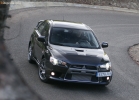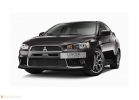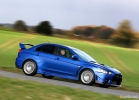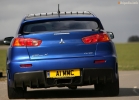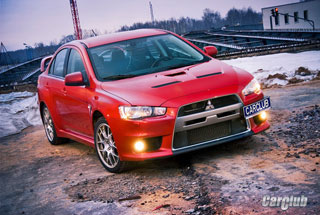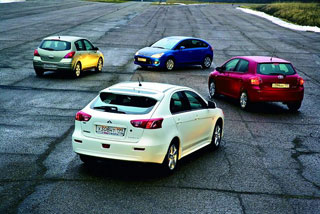Mitsubishi Lancer Evolution X test drive since 2008 sedan
Mitsubishi Lancer 4WD test drive: Leadership Application
 Mitsubishi Lancer with a 2.0 liter engine and 4WD all -wheel drive has only two execution options that differ in the level of equipment: Intense and Intense+.
Mitsubishi Lancer with a 2.0 liter engine and 4WD all -wheel drive has only two execution options that differ in the level of equipment: Intense and Intense+. With the release of the tenth family, the Lancer model has moved to a higher level in the automotive hierarchy. If Lancer IX was more positioned as an affordable family and reliable car, then the current generation has shifted priorities towards sports and aggression. An impressive appearance and increased dimensions did not leave a trace from the good -natured gaze of the nine. By the way, we have already published an article on Mitsubishi Lancer X with a 2.0-liter engine and variator. However, this time the version of this model, which received a 4WD prefix, which means the presence of all -wheel drive, came to us.
 So, the all-wheel drive version of the Lancer X is equipped with a 2.0-l with a capacity of 150 hp with a engine with a 5-speed manual gearbox or CVT with the possibility of manual switching, as well as a multi-mode all-wheel drive transmission on Demand 4WD with electronic control and automatic connection of the rear The drive when slipping the front wheels, similar to the one that is installed on the Mitsubishi Outlander XL SUV. Differences in the cabin and a monoprodic Lancer are the presence of a special all -wheel drive modes switch, which is located on the central tunnel between the front seats, as well as the visualograms for displaying the transmission mode on the on -board computer display.
So, the all-wheel drive version of the Lancer X is equipped with a 2.0-l with a capacity of 150 hp with a engine with a 5-speed manual gearbox or CVT with the possibility of manual switching, as well as a multi-mode all-wheel drive transmission on Demand 4WD with electronic control and automatic connection of the rear The drive when slipping the front wheels, similar to the one that is installed on the Mitsubishi Outlander XL SUV. Differences in the cabin and a monoprodic Lancer are the presence of a special all -wheel drive modes switch, which is located on the central tunnel between the front seats, as well as the visualograms for displaying the transmission mode on the on -board computer display. 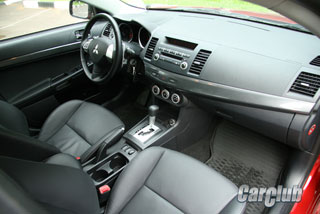 Using the switch, the driver can choose one of the three transmission modes: 2WD (torque directed at the front axle), 4WD (the system doses the direction of the torque to the rear wheels, depending on the position of the accelerator pedal and the difference in the speeds of the front and rear wheels for optimal. Distribution of torque between the axes in specific traffic conditions), Lock (more than the moment is distributed on the rear axle, due to which the adhesion to the surface increases and stability at high speeds, uneven surface and slippery coating improves).
Using the switch, the driver can choose one of the three transmission modes: 2WD (torque directed at the front axle), 4WD (the system doses the direction of the torque to the rear wheels, depending on the position of the accelerator pedal and the difference in the speeds of the front and rear wheels for optimal. Distribution of torque between the axes in specific traffic conditions), Lock (more than the moment is distributed on the rear axle, due to which the adhesion to the surface increases and stability at high speeds, uneven surface and slippery coating improves). In other words, the first mode is used as an economical when the driver is enough only the front axle. When choosing a 4WD, the system involves the behind the circuit controlled electronics for the automatic and smooth distribution of most of the torque on the rear wheels, automatically increasing this ratio when the gas pedal is pressed. The coupling directs up to 40% traction to the rear wheels when the gas pedal is fully pressed and reduces this indicator to 25% at a speed of more than 64 km/h. With uniform movement at cruising speeds, up to 15% of the available torque is directed to the rear wheels. At low speeds in steep turns, the force is reduced, ensuring a smooth rotation.
 In difficult conditions, for example, when moving along snow or ice, you can enable the 4WD Lock mode. In this case, most of the torque is transmitted to the rear wheels. For example, when accelerating on the rise of the coupling, it will immediately transmit most of the torque to the rear wheels to ensure the clutch with the road of all four wheels, when, as in automatic 4WD mode, the moment on the rear axle will begin to be transmitted only after the electronics notes the slipping of the front wheels.
In difficult conditions, for example, when moving along snow or ice, you can enable the 4WD Lock mode. In this case, most of the torque is transmitted to the rear wheels. For example, when accelerating on the rise of the coupling, it will immediately transmit most of the torque to the rear wheels to ensure the clutch with the road of all four wheels, when, as in automatic 4WD mode, the moment on the rear axle will begin to be transmitted only after the electronics notes the slipping of the front wheels. The mode of operation of the coupling is calculated on the basis of a direct communication system that works in unison with an effort to press the accelerator pedal, and a feedback system that tracks the speed of all
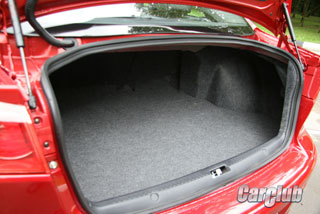 four wheels and calculating the difference in rotation of the front and rear wheels. Information about the position of the accelerator pedal and the speed of the car is transmitted through the CAN tire. The system evaluates the road conditions and effort on the pedals and directs the necessary share of torque on the rear wheels. Coming through the coils, the current generates the magnetic force that involves the clutch. In response to this force, the ball in the fist mechanism is drawn and generates the progressive impulse. This impulse affects the main clutch, and the torque is transmitted to the rear wheels.
four wheels and calculating the difference in rotation of the front and rear wheels. Information about the position of the accelerator pedal and the speed of the car is transmitted through the CAN tire. The system evaluates the road conditions and effort on the pedals and directs the necessary share of torque on the rear wheels. Coming through the coils, the current generates the magnetic force that involves the clutch. In response to this force, the ball in the fist mechanism is drawn and generates the progressive impulse. This impulse affects the main clutch, and the torque is transmitted to the rear wheels.  Unfortunately, the test time was not for the snow winter, so we could not feel all the charms of all -wheel drive. Without extreme, but in a fairly dynamic mode, it was not possible to evaluate a fairly dynamic mode on the dry coating of the advantages of an all -wheel drive model. The dough days fell on rainy weather, and Lancer 4WD managed to ride on wet asphalt. Holding the behavior of front -wheel drive modification in mind, we went in search of a suitable bundle of turns. Fortunately, in the nearest Moscow region there are still places where, with a rather flat asphalt, there is actually no movement. The segment that was chosen to test controllability consisted of two turns, one of which was quite sharp, and the other was more straight, but quite long. Having tried the all -wheel drive Lancer in various speed modes, it can be stated that the managerial on slippery coating has really become better. The presence of all -wheel drive can be characterized by one phrase, which has repeatedly heard from both journalists and other owners
Unfortunately, the test time was not for the snow winter, so we could not feel all the charms of all -wheel drive. Without extreme, but in a fairly dynamic mode, it was not possible to evaluate a fairly dynamic mode on the dry coating of the advantages of an all -wheel drive model. The dough days fell on rainy weather, and Lancer 4WD managed to ride on wet asphalt. Holding the behavior of front -wheel drive modification in mind, we went in search of a suitable bundle of turns. Fortunately, in the nearest Moscow region there are still places where, with a rather flat asphalt, there is actually no movement. The segment that was chosen to test controllability consisted of two turns, one of which was quite sharp, and the other was more straight, but quite long. Having tried the all -wheel drive Lancer in various speed modes, it can be stated that the managerial on slippery coating has really become better. The presence of all -wheel drive can be characterized by one phrase, which has repeatedly heard from both journalists and other owners 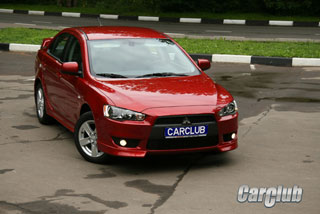 all -wheel drive cars are confident. However, a car with two leading axes requires certain driving skills, especially when the skids begin, so it is important that confidence does not grow into self -confidence.
all -wheel drive cars are confident. However, a car with two leading axes requires certain driving skills, especially when the skids begin, so it is important that confidence does not grow into self -confidence. As for cross -country ability, the road clearance of 150 mm will not allow large trump cards on the off -road, however, in the blurry rut or in the snowy court, the chances of getting stuck sharply. In automatic 4WD mode, when the front wheel is slipped, the rear axle connects without delay, preventing the car from burying.
 Mitsubishi Lancer with a 2.0 liter engine and 4WD all -wheel drive has only two execution options that differ in the level of equipment: Intense and Intense+. The Intense version with a 5-speed manual transmission, including an on-board computer, climate control, rain and light sensors, CD/MP3 discs for 6 discs, a sports suspension with a clearance of 150 mm, stretching between the front shock absorber racks and 16-inch alloy wheels, It will cost 674 020 rubles. For a stranded variator, you will have to pay another 31,088 rubles. And the top execution of Intense+, in which the leather finish of the seats is added, costs 745 308 rubles. If you take the same complexion with all -wheel drive and without it, then the difference in price will be 21,976 rubles.
Mitsubishi Lancer with a 2.0 liter engine and 4WD all -wheel drive has only two execution options that differ in the level of equipment: Intense and Intense+. The Intense version with a 5-speed manual transmission, including an on-board computer, climate control, rain and light sensors, CD/MP3 discs for 6 discs, a sports suspension with a clearance of 150 mm, stretching between the front shock absorber racks and 16-inch alloy wheels, It will cost 674 020 rubles. For a stranded variator, you will have to pay another 31,088 rubles. And the top execution of Intense+, in which the leather finish of the seats is added, costs 745 308 rubles. If you take the same complexion with all -wheel drive and without it, then the difference in price will be 21,976 rubles. 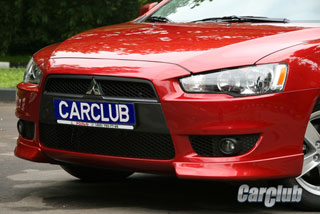 For less than 750 thousand rubles, we get a full -wheel drive system and a fairly good package. Although there are complaints about equipment. For example, in the presence of climate control and leather salon, the developers did not bother to pay attention to such trifles as the inner handle on the lid of the trunk or the backlight of cosmetic mirrors, which have long become the norm for most modern models, the stabilization system is not available even as an option. Also, despite the excellent ergonomics and convenient landing, the absence of longitudinal adjustment of the steering column disappointed. Otherwise, the appearance of an all -wheel drive transmission makes Lancer one of the most favorable offers, at least on a price feature.
For less than 750 thousand rubles, we get a full -wheel drive system and a fairly good package. Although there are complaints about equipment. For example, in the presence of climate control and leather salon, the developers did not bother to pay attention to such trifles as the inner handle on the lid of the trunk or the backlight of cosmetic mirrors, which have long become the norm for most modern models, the stabilization system is not available even as an option. Also, despite the excellent ergonomics and convenient landing, the absence of longitudinal adjustment of the steering column disappointed. Otherwise, the appearance of an all -wheel drive transmission makes Lancer one of the most favorable offers, at least on a price feature. Ruslan Galimov
The price of the tested car is 745 308 rubles.
Complete the test of the tested car
CVT Sport Mode - Standing Variator
Steering wheel switch CVT gearbox switch
Moine -resistant all -wheel drive transmission ON Demand 4wd
Flight wheels
Leather finish of seats
Seat heating
climate control
Audio training, 6 speakers
6 disk CD-MP3-changer, radio receiver and digital quartz clock
Steering wheel with an audio control buttons
Leather steering wheel
Rain sensor, light sensor
Front bumper painted in the color of the body
Headlights with halogen lamps
Rear fog light with a function of automatic shutdown
Upper stop signal
Front fog lights
Front two -stage inflatable airbags for the driver and front passenger
Side inflatable airbags for the driver and front passenger
inflatable safety curtains
Inflatable pillow for driver knees
ISO-FIX children's seat mount
ABS (anti -lock system of brakes) integrated with EBD (electronic system distribution system)
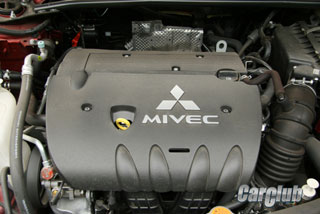 Specifications
Specifications Body
Type of body sedan
The number of places 5
Trunk volume, l 315
Equipped mass, kg 1350
Full mass, kg 1850
Length, mm 4570
Width, mm 1760
Height, mm 1505
Wheel base, mm 2635
Road clearance, mm 150
Engine
Type gasoline
The location in front is transversely
Location and number of cylinders 4 in a row
Working volume, cm 1998
Cylinder diameter/piston stroke, mm 86.0 x 86.0
The degree of compression is 10.0
The number of valves per cylinder 4
Maximum power, L.S./rpm 150
Maximum torque, nm/rpm 198
Transmission
Gearbox Cuneonus variator
The drive is connected full
McPherson front suspension with a reptile stability stabilizer
The rear suspension is independent multi -link with a reptile stability stabilizer
Front brakes Disco ventilated
The rear brakes are disk
Tires 205/60 R16
Dynamics
Maximum speed, km/h 200
Acceleration time 0-100 km/h, from 10.5
Fuel consumption, l/100 km
city cycle 10.8
country cycle 6.6
mixed cycle 8.1
Fuel tank capacity, l 59
AI-92 fuel
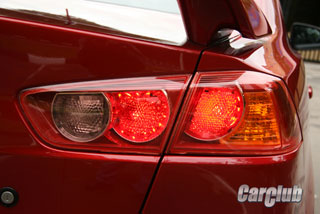

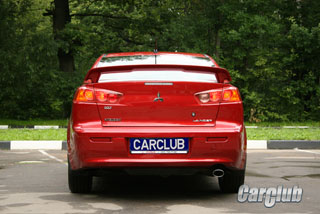
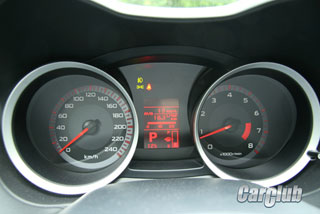




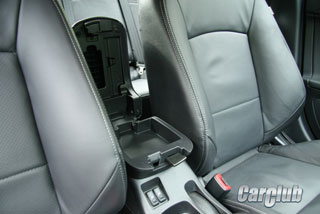




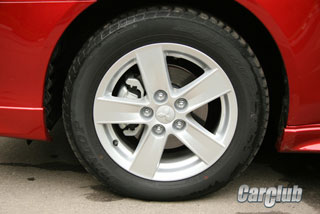
Source: Carclub.ru

